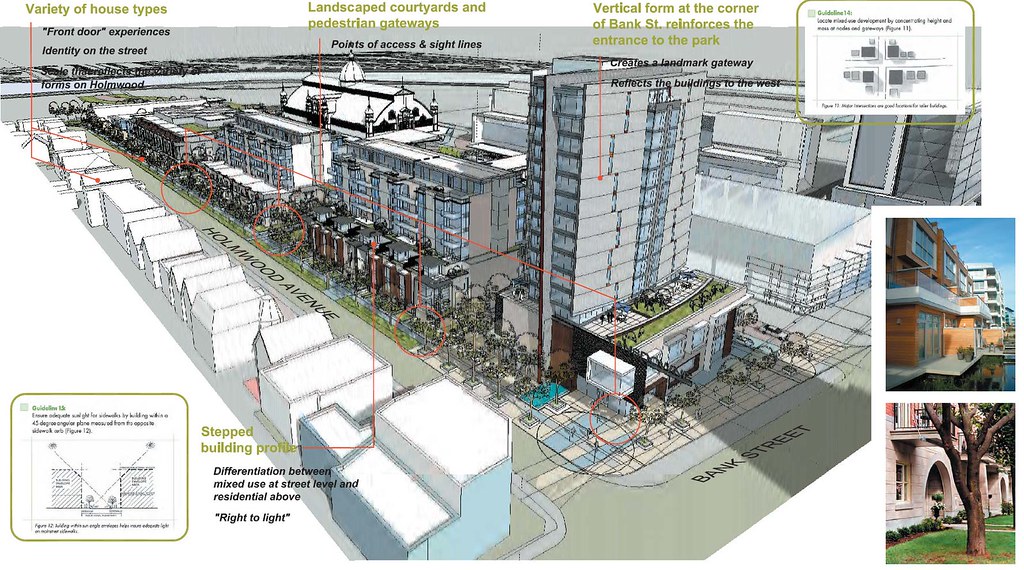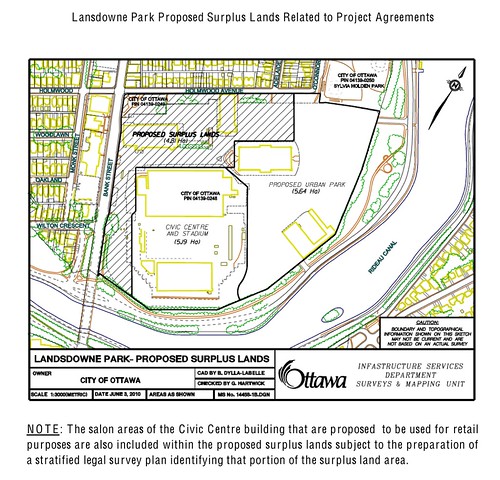
Editor’s note: The following opinion piece by Tim Lash takes the form of an open letter to decision-makers and the general public in advance of the June 28 council vote on the OSEG proposal for the renewal of Lansdowne Park.
re: Visual Resources for Civic Lansdowne Decisions, and a Request
Dear Ottawa residents, councilors and mayoral candidates,
OSEG and City staff have split up their design and publicity about Lansdowne’s future into separate parts: (1) the major part faced by Bank and Holmwood that would be given to OSEG for private development, (2) the stadium and Ottawa Civic Centre, (3) the remaining public space near the canal (which might include an “overlap” area north of the Aberdeen Pavilion).
The parts have been put forward out of sequence, partially, with shifting goal-posts and assumptions. The split hides the significance and impact of what would be given over to private development. It would be wrong to make a legal commitment on this basis. Please don’t.
To be right, Lansdowne has to be shown whole – what it is now, and what’s proposed. Only so can everyone concerned
• consult honestly and make civic decisions that are good socially, economically and environmentally
• plan and design coherently so objectives for Lansdowne Park are met in reality, and won’t cancel each other out, or let one subvert another, and
• achieve a place that works with people’s surrounding activities, places, and facilities.
Now that some pictures can be seen of the parts together, it’s clear intense private commercial development dominates this OSEG plan and proposal. It represents monopolistic control of revenue-generating assets and activities, by a single highly-favoured consortium. It shows complete loss of existing public assets like Sylvia Holden Park at the Bank Street corner, and loss of future public activity options throughout.
There’s a new diagram of ‘proposed surplus lands related to project agreements’ (3 June, see below). It explicitly shows even Ottawa’s Civic Centre salon rooms – the very places for public meetings, the heart of civic life – as “surplus” to be permanently transferred to private retail use. As well, it shows total conversion of the “overlap” area to private ownership.

Shown earlier and openly, these intentions of the developers would have been publicly rejected immediately. Taken in now, the knowledge may yet help to restore the civic quality of decisions in Council.
The key mistake was at the top at the start – making city staff the committed development partner of a pre-selected private proponent, instead of working for us all to develop and consider options. As a result so far, the work of OSEG and the city staff together would entirely change who controls Lansdowne, and who they are accountable to.
Lansdowne Park is now in public control by councillors accountable to citizens. The ability to host private activities and contract private services is used to meet public ends, following public policies. The current proposal is to shift Lansdowne to private and mixed control by corporations who are not accountable to voters or Council. Public activities and assets would become means and resources to support private ends. Future public consultations would legitimately become simply marketing. Signing a contract with OSEG would seal it. That’s the gold ring to be gained or lost in Council’s decisions this month.
In these pictures we aren’t looking at a public place where a small amount of public use has been converted to private to help pay for a new facility. That idea might have been made into a good partnership and order of precedence for a public space. The OSEG proposal was portrayed this way at the beginning. It was misleading.
We’re looking instead at a major conversion of a prime public place into a private place, with an almost complete inversion of public control to private control. The remaining public assets are buried behind a wall of intense and high energy-profile development along Bank and Holmwood. This would be a drastic un-consulted change from “main street” zoning that fits the surroundings. And it would eliminate better options without asking – like a tall-treed, green Bank Street interface with a world-class regional public activity park.
Along with a dominating commercial presence, the order of what serves what would be reversed. The retail studies are now explicit: they say public activities should be planned to support retailers’ requirements. In the draft legal agreement, just released, the mask has dropped: the “public” facilities would be constructed and managed exclusively by OSEG. The remaining open space would serve the developers as a free amenity that boosts sales potential for new private condominiums, hotel and retail. (Normally it’s the other way round – new developments have to provide new amenity to the public.) The mayor, who was elected to hold taxes level, now supports additional public costs of about $40 to $80 million for the remaining public space, and has said it’s too early to fret about them.
Add this bill to the taxpayer costs required for the proposed new stadium, replacement trade centre, and public services and infrastructure to support the private development. For this amount, Ottawa can have a new stadium and a whole beautiful active park without taking on OSEG at all.
Questions about a stadium for Ottawa, about design directions and principles, about feasibility of transportation and infrastructure, about financial details – all these are important in themselves.
But on the carousel of the Lansdowne process right now, they’re distractions, diversions from the developers’ central quest to seize the gold ring: private control of Lansdowne.
It’s almost in their reach.
Voters, councillors, and civic-minded mayoral candidates – it’s time to pull back this rashly exposed prize and recover it firmly. Please do.

3 comments
If the city was negotiating from a position of strength it could insist on better preserving the historic site lines of the Aberdeen, it could preclude the movement of the Horticulture building, it could scale back the size of the condo buildings and reduce the retail development to a something more reasonable.
However, the developers have the city over a barrel due to the city’s silly “revenue neutral” delusion. The city has acquiesed to almost everything that the developers want in order to maintain their fig leaf of fiscal probity. There is nothing inherently wrong with a small amount of private development on the Lansdowne site, but what is being proposed is too much, is out of character with the surrounding neighbourhood and really is not even necessary. If Ottawans want something good at Lansdowne we should put our money where our mouth is and be prepared to pay for it. If we try to get something for nothing as we are doing here then we will get what we deserve, a mediocre, overly commercial and over-built site without the transportation infrastructure to support it.
Dave, interesting point. The City IS in a position of strength, though. Staff and Council just aren’t using this strength for the public at this point.
The financial model is only “revenue neutral” on an accounting sheet that’s too small to cover all the additional taxpayer running costs that would happen. And the model’s “asset blind”. In it, if the city’s estimated costs rise, they have to be covered by giving the developers more public space or higher commercial density to use, to generate more revenue. But this loss of public asset or amenity doesn’t show in the model. So voters get no opportunity to agree or disagree with how much publicly- controlled public asset or activity would be converted to private.
I don’t think the developers have the City over a barrel. Nothing’s signed yet. It’s more the City is bewitching itself with a faulty and incomplete financial model.
And now we have this complication of a proposed “monopoly” clause thrown into the mix.
http://www.cbc.ca/canada/ottawa/story/2010/06/24/lansdowne-stadium-football-monopoly.html